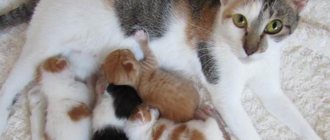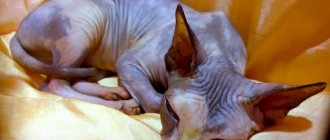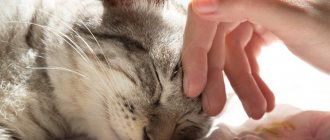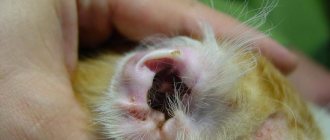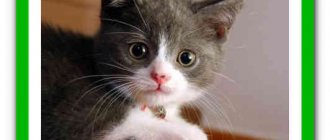Childbirth is the process of the appearance of offspring, established by nature in most animals. If your pet becomes pregnant, you should find out in advance how cats give birth. After all, your pet may need your help at the time of labor, especially if any complications begin. In addition, the cat and its offspring will definitely need care after giving birth. And the owner must provide them with all this.
Signs of labor in a cat
The owner of this type of mammal should know how to understand that a cat is giving birth. Veterinarians have identified several signs of imminent labor:
Advertising:
- 2-3 days before birth, the body temperature of the expectant mother drops to 37°C;
- and the mammary glands, on the contrary, become hotter and swell, this is due to the fact that they are actively producing a nutritional mixture for kittens;
- 2 days before the start, the pet’s genitals swell and become pinkish;
- a few hours before the start, the cat begins to actively lick itself;
- the pet’s activity decreases, it becomes apathetic, it is better not to disturb it during this period;
- the day before giving birth, the cat completely stops eating food, however, it must be fully provided with drink;
- a few hours before giving birth, the cat practices “training”, that is, it begins to arch, as if during contractions, from this moment it is better to be near it constantly;
- if the pet is attached to the owner, then she will constantly follow him and meow loudly, since she is not comfortable and requires support and help.
Length of pregnancy in cats
Pregnancy in cats lasts 63-66 days. In some cases it lasts 58-72 days. A cat expecting offspring behaves calmly and sleeps a lot during the day. Her appetite increases and she needs more water.
From the first days of pregnancy, a cat needs vitamins with a high calcium content. The drugs “Brevers East” and “Brevers Tabs” have proven themselves well.
Often, between the 3rd and 4th weeks of pregnancy, the expectant mother may develop toxicosis. She will vomit several times a day, and her health will noticeably worsen. On days 21-28, swelling of the nipples is observed. In another week, the cat's tummy will begin to grow.
From now on, you should treat her with special care. There is no need to pick up the cat, but if the need arises, this should be done carefully. The animal is grasped by its front paws; with the other hand you need to support its back part.
It is important to provide the cat with complete rest and try not to touch it with a door, chair, or foot. It is allowed to play with the animal. During pregnancy, the expectant mother should eat high-quality food. The room where the cat lives must be ventilated.
On the 35-50th day of pregnancy, you need to organize a place where the British woman will give birth. A medium-sized box is suitable for this. One of its sides needs to be cut off. This will allow the cat to freely jump into it without stepping on its offspring. However, it should be trimmed in such a way that the kittens cannot freely get out of their “home” in the future.
You can place a clean rag or newspaper at the bottom of the box. To maintain cleanliness in the box, the litter will have to be changed periodically. It is advisable to introduce the cat to a new place in advance. The animal will get used to it and will feel more calm.
As a rule, cats do not need help during childbirth and cope with everything on their own. However, many owners are very worried about their animal and want to help it. Learning how to give birth to a cat is not difficult, the main thing is to prepare everything you need and not be afraid.
We deliver babies
For childbirth you will need the following:
- scissors for cutting the umbilical cord;
- a disinfectant in the form of alcohol or vodka, which should be used to treat scissors and hands;
- “Traumel” is a homeopathic medicine for injection (in the case of using “Traumel”, pipettes will be needed);
- clean diapers;
- a small bulb for pumping out fluid from the oral cavity of newborn kittens;
- disposable diapers;
- if the cat is long-haired, you need to prepare 2 socks (they will need to be put on the animal’s hind legs. This is necessary so that the cat does not get smeared with blood);
- telephone numbers of veterinarians or veterinary services working around the clock.
As mentioned above, the pregnancy of a British cat lasts about 66 days from the date of mating. Fluctuations of up to 72 days are allowed. How long the pregnancy will last depends on the breed of the animal, its age, excitability, health status, climatic conditions and other characteristics.
Signs of imminent pregnancy
Harbingers of labor can be small mucous discharge that appears 3-5 days before the onset of labor. During this period, the cat will be puzzled by finding a place to give birth. She may hide in a closet or under the bed, not remembering the box prepared for her.
Sometimes a cat tries to get closer to its owner, clings to him and hopes for his support. If during this it becomes noticeable that the cat’s stomach has dropped, then most likely new residents will appear in the house soon. In this case, the cat may begin to visit its litter box frequently and completely refuse to eat. All this suggests that there is very little time left before labor begins.
Preparing for childbirth
If according to signs the cat is expected to give birth within the next 24 hours, then you definitely need to prepare for this. It’s better to do this in advance, a few days in advance, so that everything is at hand. All preparation is carried out in several stages.
Preparing the birth site
The expectant mother must get used to the parenting place in advance. Therefore, the box in which the birth will take place should appear in the house at least a week before the significant event. If this is not done, the pet will choose its own place. This could be a closet or just a secluded corner. At the same time, it is almost impossible to convince the pet to move into the box in this case.
Box requirements:
- the cat should be able to stretch out to its full height inside, and at the same time there should be enough space for the kittens;
- the height of the container should be approximately half a meter;
- the exit must be made in such a way that the mother can calmly get out and go back in, but the kittens cannot;
- A small soft pillow should be placed on the bottom, which should be wrapped in a waterproof cloth, and an absorbent cloth should be placed on top.
If before giving birth the cat did not enter the prepared house on its own, then it should be carried and placed inside. At the same time, she needs to be stroked and calmed down, and made to understand that it is better to give birth to offspring here.
Preparing tools
Owners should have everything they need on hand:
- lots of rags;
- several pairs of sterile gloves;
- sterile bandages and napkins;
- surgical thread for tying the umbilical cord; a couple of hours before birth, they should be placed in a container with alcohol for disinfection;
- small scissors with rounded ends;
- a baby syringe, which will be needed to suck out liquid from the nose or mouth;
- scales, a writing object, blank paper, a watch to record and record all events;
- disposable syringes;
- a garbage bag to store used materials and tools.
Medications
Stock up on a small first aid kit, which should contain:
- hydrogen peroxide;
- brilliant green or potassium permanganate;
- alcohol, cognac or other alcoholic drink;
- oxytocin.
How to care for a pregnant British cat
Normal care during pregnancy of a British cat - what is it like?
- Mandatory examination by a veterinarian. It makes sense to carry out the first such examination 2 or 3 weeks after the expected conception. While the cat is bearing offspring, only a specialist has the right to prescribe research methods and medications. A pregnant British cat perceives even previously familiar anti-parasite medications differently. Inspection should be regular. The last week is a must for him.
- Is weight control necessary? Extremely desirable: while the pregnancy lasts, the expectant mother should walk more in order to avoid obesity. In addition, muscle tone is maintained. True, the last period requires increased control over the pet’s activity - when conquering great heights, excessively active play with other animals or people, injury is possible.
- Reasonably organized feeding is an important stage in caring for the expectant mother. It is recommended to feed her with special food for kittens for about a month. She also needs calcium, protein and other nutrients, just like a kitten. Balance is extremely important, so you should not feed your pet at this time with the usual delicacies, table scraps. So she will not receive nutrients. After a month, you should pay attention to food with a high protein content. A week before an important event, the cat loses its appetite. She should not be forced to eat - the abdominal cavity is filled with offspring, so there cannot be an increased appetite.
- It is worth helping to organize a cozy place for the expectant mother. At critical times, she will prefer to stay in a dry, warm, calm, quiet, semi-dark place. No strangers, no noise! A spacious, durable box with a removable lid and an opening at cat level is ideal. It is recommended to use several layers of newspaper as bedding.
How does childbirth occur in cats?
You can determine that your cat will go into labor in the next few hours by looking at the contractions.
Moreover, the closer hour X is, the stronger they become. In general, if everything goes smoothly, according to the rules laid down in nature, then you won’t even have to give birth. But just in case, it is better to stay with your pet until the end. Many owners may also be interested in how many kittens a cat can give birth to. In general, such an animal is capable of giving birth to almost any number of kittens. For example, there have been cases when one cat gave birth to one kitten, and another 14. If we take the average, then cats give birth to approximately 4-7 kittens at a time.
First birth of a cat
If the cat has not given birth before, this means that double attention to the mother will be required during the process. The first birth does not require any special preparation. But it’s worth repeating once again that you should carefully observe the process itself and be ready to help your four-legged friend, since due to inexperience she may get confused.
How to prepare a cat for childbirth?
It is only possible to prepare a cat for childbirth, if it does not have any abnormalities, only morally. It’s worth trying to pet her and calm her down. But if the cat doesn’t give in, tries to run away, scratch or bite, then it’s better not to touch it.
If spasms, that is, contractions of the uterus, can be felt by placing your palm on the stomach, then it’s time to transfer the cat as carefully as possible to the maternity box. Don't forget that you need to calm her down and pet her. If the cat immediately left the box, then it is not recommended to bring it back there again. Since she won’t give birth there anyway.
Childbirth
Before the onset of labor, a British cat restlessly follows its owner, meows anxiously, and licks its fur. You need to be especially careful the day before the expected event. Within 12-14 hours, body temperature begins to drop to 37.9 °C. Before labor begins, it is necessary to study the main stages of the birth of babies.
As soon as contractions begin, you need to put her in a prepared box with a clean diaper. The crumbs appear at intervals of 40-60 minutes. Kittens are born in a bubble. The mother chews the shell and licks the cubs: it stimulates the respiratory function of newborns. After this, the cat chews the umbilical cord. The animal most often eats the delivered placenta.
The birth process lasts from 2 to 14 hours.
Why might there be few kittens?
Having studied the question of how many babies British breed cats give birth to for the first time, you may not be surprised at the appearance of one baby from a young favorite. In the first litter, 1-3 cubs are usually observed.
Why can there be many kittens?
Multiple births are transmitted through the female line and depend on the number of previous lambings. An adult cat that has given birth can produce more kittens, 4-5. Especially if she herself appeared as a result of a multiple pregnancy.
Different kittens from the same litter
Genetically identical babies may differ in color. Babies receive a different set of genes from their parents, which is why different kittens appear from the same litter.
Stages of lambing for a cat
You can find out the answer to the question: how kittens are born from the list below:
- Passage through the birth canal. At this stage, the cat is pushing. On average, 5 attempts are enough to give birth to one kitten.
- The birth of a kitten. The baby is born in the amniotic sac, or less often in its remains. In the latter case, a yellow liquid will be released from the vulva (the cat's genitals). There's nothing wrong with that.
- The baby begins to breathe. The cat should burst the bubble and lick its baby to clear its airway. If the baby squeaks at the end of licking, this is a good sign.
- Working with the umbilical cord. At this stage, the cat chews the umbilical cord and eats the afterbirth, which helps stimulate pushing. But if the cat has given birth to more than 3 kittens, then do not let her eat more than three afterbirths, as this may cause vomiting.
- Feeding. Immediately after stage 4, the baby should suck on the mother's nipple; if he is unable to do this, help him, but carefully. After some time, labor will continue, starting with the first stage, until all the kittens are born.
Second phase
The second stage is the natural birth of British babies. They should come out head first (it rarely happens the other way around), in the amniotic sac, which the new mother bites through and at the same time gnaws through the umbilical cord.
How to give birth to a British cat? It is necessary to carefully release the kitten from the amniotic sac, wipe it, cut the umbilical cord, leaving up to 2 cm from the abdomen. Carefully treat the edge of the umbilical cord with an antiseptic. You need to carefully examine the newborn, make sure that breathing is uniform , if not, then you need to lower him head down and hold him in this position until he squeaks. The tongue should be pink.
Place all the kittens in one place. As soon as the stages of labor for the British cat are over, bring a spacious box of kittens to the British cat so that she lies down next to them and feeds them.
In what cases do you need to urgently contact a veterinarian?
You should contact your veterinarian if your cat begins to give birth much earlier than expected. Many people do not know how long it takes for cats to give birth normally. The normal pregnancy period is 60-70 days, and then there are deviations. In this case, most likely, the offspring will be born dead or premature, which will also lead to death.
If a cat does not give birth for more than 70 days, then this is also a direct reason to contact an animal doctor. Most likely, all the pets died in the womb and the cat urgently needs to be saved from infections and other dangerous consequences.
If the cat cannot calve completely within 3 hours. This phenomenon is called frozen labor. In most cases, if you call a veterinarian to your home in time, everything ends well.
Discharge of any color that smells pungent also does not bode well. And if the cat cannot give birth within an hour, then she will soon bleed. It is better to call the veterinarian in advance so that he can arrive.
What kind of participation in childbirth is necessary from the owner?
- If the cat cannot give birth, the kitten seems to be half-stuck: put the cat in the “pooping” position, take a soft cloth and gently pull the baby by the scruff of the neck, rocking it left and right, synchronously with the contractions. Do not grab the body or limbs! If the baby walks with his feet, do not break the bubble; if with your head, you can help him break the bubble so that he can breathe.
- The cat is in no hurry to free the baby from the bubble and/or gnaw his umbilical cord: do it yourself as quickly as possible by breaking the bubble on the kitten’s face. Then you wipe the head with a napkin and use your finger in the same napkin to clear your mouth of mucus. Gently pinch the kitten, shaking it a little. Now you can cut the umbilical cord 2 centimeters from the baby’s tummy, having first tied it with a thread, disinfect it with peroxide and apply a cotton swab with iodine for a second. You should also cut the umbilical cord yourself if after the birth of the cat the mother did not do it herself within 5 minutes.
If the born kitten is not breathing, place it between your palms and gently bend and unbend its body so that its knees reach its chest. Point the nose towards the floor, down
Important! Any actions with the umbilical cord should not pull down the kitten's tummy.
- The afterbirth does not come out: you can try to very carefully pull it out by the umbilical cord. If unsuccessful, 2-3 hours after the cat has given birth to all the babies, give her an injection of oxytocin (0.2 ml) in the thigh.
- The born kitten is not breathing: place it between your palms and gently bend and unbend its body so that its knees reach the chest. Point the nose towards the floor, down. If these manipulations do not help, you can put the kitten between your palms with its head towards your fingers and shake it vigorously but gently, swinging it as if you were chopping wood, sharply lowering your hands down. Make 3-5 such movements, now massage the breast and entire body with your index finger, and then suck out the mucus from the mouth and nose with a rubber bulb. Continue these manipulations until the baby begins to breathe.
If something goes wrong during the birth process and you cannot control it, call your veterinarian immediately
Giving birth to a cat at home
In general, you should not interfere with childbirth if the expectant mother does not need help. But again, you need to control the entire process. All births are divided into three categories according to complexity. See below for more details.
Easy birth
This is a normal birth where the cat does not require human assistance. In this case, there is no need to interfere with this natural process.
Middle birth
In this case, the cat and its offspring require minimal human assistance. For example, it is necessary to induce labor, pull the kitten out of the birth canal, or open the bladder in which the baby was born. All this should be done only with sterile things, always wearing gloves.
If the kitten does not squeak after the cat has licked it, you should resuscitate it. To do this, try to clear the airways. If it doesn’t help, then rub it on the chest and back with a towel for 3-4 minutes. You can try to gently shake the kitten like a thermometer, but this is a last resort.
Difficult birth
In this case, a caesarean section may be necessary. An ordinary person is helpless in this case. Here you need to call a veterinarian at home. And if even earlier, during the examination, it was known that the birth would be difficult, then you should take the cat to the veterinarian in advance so that he can professionally deliver the baby.
Induction of labor
The average interval between the birth of kittens in a cat is from 5 to 60 minutes. Therefore, there is no need to induce labor until the deadline has passed. If there is still a need for this, then you need to use oxytocin. If your pet weighs 5 kg, you should give 0.3 ml of this drug once an hour. There is no need to administer the drug more than 3 times, as this can lead to serious problems, for example, weakening of the body.
Possible assistance during childbirth
You can read about how to understand that a cat is about to give birth in our article “Signs of the onset of labor in a cat, harbingers.”
The process of giving birth to kittens is divided into several successive stages:
- preparatory, when the cat begins to have contractions that turn into pushing;
- the immediate birth of kittens (their exit through the birth canal);
- postpartum (recovery) period.
At the preparatory stage
The cervix opens and the birth canal prepares for the birth of the fetus. The amniotic sac is expelled, bleeding may appear, breathing becomes more frequent, and body contractions (contractions) appear. This period can take from several hours to a whole day. Conventionally, the stage ends when the kitten’s head appears in the birth canal.
What should the owner do: during this period, nothing needs to be done except observe the general condition of the cat from the outside. If the pet is restless and eager to be with people, you can be nearby, pet it, and calm it down in a calm voice. If the head of the first kitten does not appear within 24 hours, this is a direct indication for taking the cat to the veterinary clinic. If the cat becomes lethargic and does not respond to calls or surrounding events, this is also a direct indication to seek qualified help from a specialist.
Birth period of kittens
The normal exit position for kittens is head or pelvis forward. After the birth of a kitten, after a certain period of time, the afterbirth leaves, which is usually eaten by the cat. The number of placenta should match the number of kittens born. The cat begins to lick the newborn itself, freeing it from the fetal membrane, and independently gnaws the umbilical cord. If everything happens as described, there is no need to interfere with the process.
We recommend reading: Experience in the use of fibrinolytic enzymes in veterinary ophthalmology
What should the owner do: if labor weakens or stops, it may be necessary to administer oxytocin, but it is forbidden to do this on your own - only after an assessment of the situation by a veterinarian in person or at least after a telephone consultation. Oxytocin has a number of side effects, which, if administered incorrectly, can cause the kitten to suffocate in the birth canal or rupture the birth canal itself if labor is excessively accelerated.
If the number of placenta does not correspond to the number of kittens, and they do not come out within the next 24 hours, you need to show the cat to the veterinarian and be sure to do an ultrasound. A stuck placenta after childbirth is perceived by the body as a foreign object, as a result of which it becomes a source of serious infection.
If the cat does not show interest in the newborn, you will have to wear gloves, free the baby from the amniotic sac, clear the airways of mucus, tie the umbilical cord at a distance of 1.5-2 cm from the tummy and cut it with sterile scissors. The wound is cauterized with a solution of betadine or brilliant green. Gently rubbing with a waffle napkin will imitate the movement of a cat's tongue. Next, the baby should immediately be slipped under the mother cat’s tit. Usually at this stage her maternal instinct kicks in and no further help is required. If this does not happen, then the listed manipulations should be repeated with all other kittens.
If the kitten is not breathing, you should check the airway by trying to clear it with a syringe. Next, turn it upside down and shake it slightly. You can blow lightly into the mouth through a gauze pad - this will fill the lungs with air, and the kitten will take a passive breath. The tongue should be pink. You can rub the chest, lightly pressing it, simulating breathing movements.
If it is noticed that the kitten cannot pass through the birth canal (for example, a large one), you can gently lubricate the birth canal with sterile Vaseline and try to gently pull.
Under no circumstances should you pull the kitten by the paws or head!!! Try to do this by the body or by the fold of skin on the back of the head (withers). It is important to do this during moments of pushing.
If the presentation is incorrect, at the moment of pushing, the kitten is pushed back and with stroking movements along the cat’s lower abdomen, you can try to turn the baby around correctly. The fetus is considered to be in abnormal position when the neck, legs, back or lower back are visible in the birth canal. Everything is done with sterile gloves. There is no need to put in excessive effort.
We recommend reading: Nightingale bird: what it looks like, where it lives and what it eats
Recovery period
The birth process is considered complete when all the kittens are under the mother cat’s breast, all the placenta have passed, the animal is calm, and there are no signs of contractions. This usually takes from 2 to 4 hours, in rare cases the process can take up to 10-12 hours. If the birth proceeded without difficulties, then the postpartum (recovery) period for the owners is usually just observational. The woman in labor is provided with complete rest and always clean drinking water nearby. Check that all kittens are suckling milk.
What should the owner do: the rules of the postpartum period for the cat owner are very simple:
- provide a complete and sufficiently high-calorie diet to the nursing cat, monitor the purity of drinking water;
- organization of peace and absence of stress;
- monitor the cleanliness of the litter in the nest;
- observe vaginal discharge;
- monitor the general condition of the mother and her babies.
Any abnormalities in the health of the cat and/or kittens should be reported to the veterinarian.
End of labor
If everything went well, all the babies came out and they are all healthy, then the cat begins to behave like an ordinary caring mother, that is:
- fully cares for its offspring (licks, feeds);
- eats and drinks fully;
- breathes calmly;
- goes to the toilet as before childbirth;
- changes position in the box;
- the stomach sank and became soft.
It is not recommended to give food to your cat immediately after giving birth. It is best to leave milk and water nearby. After two to three hours, you can give your pet her usual food. If the cat does not eat for 6 hours, then you should not pay attention to it. But if it drags on for a longer period, then it is better to show your pet to a veterinarian.
Pregnancy time
During pregnancy, cats of the British breed will have to abstain from fish and seafood, as they can destroy the B vitamins that she and future offspring need. An excellent replacement would be yogurt mixtures, curd mass, and kefir. They contain a lot of calcium, which contributes to the proper formation of the cat's skeleton.
© shutterstock
On the 35th day, a rounded belly is already clearly visible, weight increases, as a result of which the gait and lifestyle in general changes (he stops running, playing, and is more capricious). When you touch it with your palm, you can feel the kittens moving.
On day 49 it is already possible to determine the number of babies. The expectant mother will become more thoughtful and slowly begin to look for a comfortable place.
By week 7, everything should be fully prepared for the upcoming event. After all, a couple of weeks and the British cat will become a mother after giving birth.
Gestation of kittens, like the natural process of childbirth, occurs differently in British cats, but there are still common signs, such as:
- active movement of babies, British cat sleeps for a long time;
- removal of the birth plug;
- breaking of water (100% sign of the onset of labor).
Possible complications
In general, childbirth is a rather complex process. Therefore, almost any complications are possible here. The owner must be prepared for any situation. The article below will discuss the most common complications.
Bloody discharge in a cat after birth
In this case, an ordinary person cannot determine the cause of the bleeding and certainly cannot correct it. If this happens, then you need to take the cat and go with it to the veterinarian as quickly as possible.
The cat does not have milk after giving birth
First you need to take care of the kittens. Veterinary clinics sell special mixtures that should be fed to kittens through a special bottle with a nipple. In extreme cases, a syringe without a needle is suitable.
As for the cat, it needs to be shown to a veterinarian so that the latter can determine the cause and correct the situation.
After giving birth, the cat came out with a bladder
In this case, there is nothing to worry about. You just need to help the cat tear it apart after it comes out completely. You shouldn't do this before.
After childbirth there was a belly
If there is a belly left, then it is likely that not all kittens managed to come out. It is recommended to palpate the abdomen. If there are kittens left there, then you need to wait an hour and then induce labor. If this does not help within 6 hours, then you need to show the cat to the veterinarian.
Eclampsia in cats after birth
Eclampsia is a serious condition of a cat after childbirth. It shows itself quite clearly:
- strong secretion of saliva;
- convulsions;
- high body temperature;
- lack of coordination.
If you start this condition, the outcome will be sad. If you notice the above signals in your pet’s behavior, you should contact a veterinarian as soon as possible.
Cat doesn't eat after giving birth
As already written above, if a cat has already lambed, but refuses to eat for 6 hours, this is the norm. Next you need to contact a veterinarian. It is also not normal for a pet to refuse clean water.
The cat does not go to the toilet after giving birth
In general, a cat’s refusal to go to the toilet for 2-3 days is normal. Since the body is exhausted: all liquid and other substances are used to produce milk to feed the offspring.
Prenatal period
First, you should think about the place where the expectant mother and her newborn babies will live. Most often, pregnant women look for it on their own; absolutely any corner in the apartment/house becomes it. But it is much better if the owners arrange it well in advance: prepare a box, soft fabrics, and possibly a cardboard lid.
There is one condition: the bulk box that will be used as a cat house must have a removable lid. It will give the owners the opportunity to observe the process, even if the pregnant woman wants to give birth alone. From time to time you will need to lift the lid to make sure everything is going correctly. Make a passage in the box itself so that the pet can exit without obstacles.
© shutterstock
Cover the bottom of the constructed cat house with a warm soft cloth and cover the top with a disposable diaper.
True, it is still unknown whether the British cat will like the good conditions for childbirth chosen by the owner and the place; perhaps she will find another, more suitable for herself and her children.
Caring for a cat after birth
It is imperative to care for your pet while she is nursing her offspring. It is better to feed the cat for the first two weeks with natural and easily digestible products of natural origin. These can be fermented milk products, cereal porridges, a small amount of boiled meat.
True, artificially bred breeds and British women should be fed for the first weeks the same as before giving birth. After this time, familiar foods return to the diet of any breed.
How to feed without a cat
Caring for newborn kittens will not be easy, because you need not only time and patience, but also certain knowledge. From our article today you will learn how to feed a kitten without a cat.
To feed a newborn pet, you will need a special mixture. Today, pet stores and veterinary pharmacies offer a wide range of artificial nutrition for pets, starting from the first days of life.
Please note that it is not recommended to give kittens formula or cow's milk. Cow product and baby food have a completely different percentage of fat content and a different chemical composition that does not meet the life standards of a small kitten.
Many people are interested in how to breed formula to feed a newborn kitten. Often, the dosage (how much water is needed for a certain amount of mixture to obtain a ready-to-use product) is indicated by the manufacturer in the instructions for use. It is also necessary to know the norms and number of meals: a kitten that is not yet a week old eats less, but more often than a 2-month-old baby.
Making the mixture at home will not be difficult if you strictly follow the recommendations of the manufacturer or veterinarian. The finished mixture is heated to 36 °C, poured into a syringe without a needle or a pipette and brought to the newborn’s face. In order for a blind kitten to lick drops of milk, it is necessary to provoke its animal instinct to feed. Before feeding, the mother cat licks her offspring, therefore the refuse kitten must be carefully stroked on the body and head.
To avoid problems with the digestive system, do not forget to carefully massage your pet’s tummy: lightly stroking the abdominal cavity in a clockwise direction is enough.
Until kittens reach two weeks of age, the frequency of meals is every two hours. Then the babies are transferred to 8 meals a day, which greatly facilitates the process of caring for cat offspring. Gradually, the syringe is replaced with a special bottle for feeding kittens, which can be purchased at a veterinary kiosk.
When a kitten is one month old, it can feed itself by lapping up formula from a shallow bowl.
Sterilization of a cat after birth
Childbirth in a cat can occur with some complications. Therefore, it is better to sterilize her so that the pet cannot become pregnant again. After all, the risk of complications during the second birth will be quite high, and most owners do not want to subject their four-legged friend to torture.
But many are tormented by the question: when can a cat be sterilized after giving birth? Veterinarians will prescribe sterilization only after the end of the milk production period - after about 3 months. Be sure to consult your veterinarian in advance.
Is it possible to sterilize a cat during childbirth?
During childbirth, a cat will only be sterilized as a last resort. Since this procedure during a cesarean section is dangerous. In addition, after sterilization, a cat may refuse to feed newborn kittens. To prevent this from happening, most veterinarians prescribe sterilization 3 months after birth.
Post-lambing care
When the kittens are born, they change the diaper in the box to a clean one and give the new mother water and food, and the babies are placed on the cat’s nipples so that they begin to eat. After giving birth, a British woman can behave unpredictably. She definitely needs rest, and she must get used to motherhood. The owner observes the following changes in the pet:
- Slightly bloated belly. This is due to the fact that the uterus has not yet contracted.
- Discharge. They are not dangerous, if they are red-brown in color and without an unpleasant odor, then after 7-10 days everything will go away, but otherwise, a doctor’s consultation is necessary.
- Diarrhea. The animal should be given boiled water and rice water. The disorder will pass in 3 days.
- Constipation. It is recommended to feed your British cat warm milk and oatmeal.
- A British woman's stool is dark or black in color. Observed when a cat has eaten the afterbirth.
The British experience childbirth very stressfully and, at first, may even refuse to feed newborns. The owner must help the cat by placing one kitten at a time on the mother’s nipple; if all else fails, then buy milk and a feeding bottle. Soon the maternal instinct will awaken, and the cat itself will take care of its charges.
